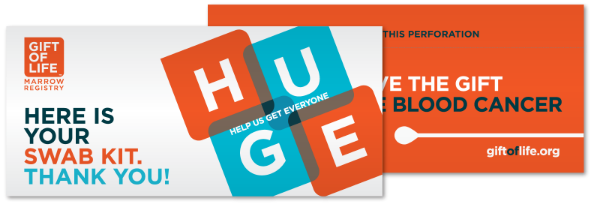


Labcorp is partnering with Gift of Life and together are working to help fight blood cancer and save lives. Patients like Sloane desperately need your support. It takes less than 5 minutes to join the registry.
Sloane is silly, razor-sharp, only 3-1/2 years old – and she urgently needs a bone marrow transplant donor. But she does not have a match in the registry. She is fighting two forms of cancer: ATRT tumors and myelodysplastic syndrome, a precursor to leukemia. Sloane has had emergency brain surgery, many rounds of chemo and radiotherapy, and in all that time her strength and sassiness defied comprehension.
At Gift of Life we believe every person battling blood cancer deserves a second chance at life — and we are determined to make it happen.
We are singularly passionate about engaging the public to help us get everyone involved in curing blood cancer, inherited immune disorders and other diseases. Whether as a donor, a volunteer or a financial supporter, you can save lives.
It begins with one remarkable person, one life-changing swab and one huge win – finding a match and a cure.
Labcorp, headquartered in Burlington, North Carolina, is a leading global life sciences company that provides vital information to help doctors, hospitals, pharmaceutical companies, researchers, and patients make clear and confident decisions. Through our unparalleled diagnostics and drug development capabilities, we provide insights and accelerate innovations to improve health and save lives.
The truth is that donating bone marrow or stem cells is purely voluntary. If you are between 18 and 35 and in good health, you can join the registry, but the chances of being called are fairly low. That doesn’t mean it’s not important to register – you could get the opportunity to save someone’s life, which is rather incredible. You can expect to change someone else’s life, but what most donors don’t expect is how meaningful donating is to them. Saving another person is big stuff.
Most people believe that only a patient’s family members can donate to them, but the opposite is true. Only about 30 percent of patients find a donor within the family. The other 70 percent must seek an unrelated donor in the worldwide registry. If no donor is found, they often run drives to recruit new donors in the hope of finding a match. The best chance of a match is with someone from the same genetic heritage, so it’s incredibly important that more people of diverse background and mixed race join the registry. Click here to learn more about the need to diversify the registry.
One of the biggest myths about marrow donation is that it’s painful and dangerous, requiring an invasive surgery. The truth is that there are two methods of donating, and both are outpatient procedures with no long-term side effects.
The most frequently used method, about 80% of the time, is peripheral blood stem cell donation. The donor spends four to six hours in a comfortable chair or bed, while blood is drawn from one arm, the needed stem cells are separated out and the remaining blood is returned to the other arm. Donors can watch movies or chat with friends during the process, and go home when it is finished.
The 20% who donate bone marrow, most often requested for children, can expect a one-and-a-half to two-hour procedure. While under general anesthesia, a doctor will collect liquid marrow from the iliac crest of the hip bone using a syringe. Donors go home after the anesthesia wears off, and may feel a backache for several days, treatable with Tylenol or similar medications. There is no long-term recovery and donors resume a normal routine in one to three days. Your bone marrow and stem cells grow back on their own, and your recipient gains a second chance at life.
With the huge popularity of genealogical DNA testing, many people wonder if Gift of Life shares any information with other organizations. Your information is protected by the same regulations that your own doctor complies with. We test for specific factors that show whether you could be a perfect immune system match for a patient, and this data is confidential. Your name does not appear in the worldwide marrow registry; only Gift of Life knows your identity.
Well, there’s one more myth that a lot of people ask us about at the swabbing table when they join the registry: Are you going to clone me? Most of them are joking, but we are asked so often that we’d like to address it. First of all, human cloning has never been done, and due to the way the nucleus of human cells is structured, will likely remain impossible for many years to come. Even if scientists someday discover a process, creating just one clone would cost many millions of dollars. We hate to disappoint everyone, but cloning you just isn’t in our budget!




